
LNG-powered ferries benefit the environment
Stricter environmental regulations are promoting the spread of ferries powered by liquefied natural gas (LNG). Norway is among the world leaders in the use of LNG ferries, and now Denmark is joining the trend. The M/F Samsø is at sea, and on board are Hoyer motors which serve important functions on the ferry.
The M/F Samsø is a Danish domestic ferry that is the country's first such vessel to be powered by liquefied natural gas. This type of ferry is much more ecofriendly than traditional models, as the use of LNG − when compared to conventional fuel oil − reduces the ship’s sulphur emissions (by 90–95%), nitrogen particles (80%) and CO2 (20–25%).
Stricter environmental requirements in European waters
OSK ShipTech is a consulting firm of marine architects and engineers behind the design of the M/F Samsø. According to Kristian Careø Lind, a marine engineer and director of the firm's Aarhus office, demand is on the rise for ecofriendly alternatives due to stricter environmental legislation.
“The more ecofriendly solutions such as LNG are gaining ground as the result of the International Maritime Organisation’s new and stricter environmental regulations, which came into force at the beginning of the year. The new rules mean that exhaust from ships that sail in the Baltic Sea, the North Sea and the English Channel may only contain 0.1% sulphur,” Kristian Careø Lind says.
Norway leads the way
The M/F Samsø is far from the first ship of its kind. In neighbouring Norway, a number of LNG ferries sail routes through the country’s fjords. There are currently 44 ships powered by liquefied natural gas, most of which are European ferries – and an additional 34 are on the way. When it comes to both existing and planned LNG ships, Norway is way ahead of the pack, though countries like Germany, Sweden, Finland, France, Croatia and Denmark are slowly joining in.
Hoyer’s motors assist in opening the bow doors.
The story of the new ferry is more than that of being an ecofriendly vessel. On board, there are electric motors from the Danish manufacturer Hoyer, which has supplied various explosion-proof electric motors for the ferry’s ventilation systems, which are used in the engine room, the LNG piping system and elsewhere in the ship.
Hoyer has also provided six 99 kW motors for two hydraulics stations, which, in addition to opening the bow door so that cars can drive on board, also power the anchor windlass and moorings.
Constructed at a shipyard in Poland
Even though Hoyer has provided motors for a Danish-designed ferry that sails in Danish waters, the motors had to cross Denmark’s border to be installed. M/F Samsø was built at Poland’s internationally renowned Remontowa shipyard, which previously constructed 10 LNG ferries.
“Hoyer Motors was first and foremost selected due to our high level of quality, our references and our maritime certifications,” says Adam Slupinski, Country Manager for the Polish market, Hoyer.
Adam is part of Hoyer’s six-person Polish team, which has worked from the company’s Hadsten office to build relationships with its business partners in Poland, which have producd ventilation and hydraulic systems.
Facts
- From 2015, ships may only run on fuel containing 0.1% sulphur while sailing the North Sea, the Baltic Sea and the English Channel. The previous limit was 1.0%.
- On a global level, ship fuel may contain up to 3.5% sulphur, but this value will be reduced to 0.5% in 2020.
- Marine diesel, which has a low sulphur content, is about 50% more expensive than normal fuel types with higher sulphur contents.
- Shipping companies can choose to use natural gas, low-sulphur fuel or to install scrubbers, which clean the fuel to remove sulphur. Each of these options represents a considerable investment for the shipping companies.
Source: The Danish Shipowners’ Association (Rederiforening), Danish Ministry of the Environment
